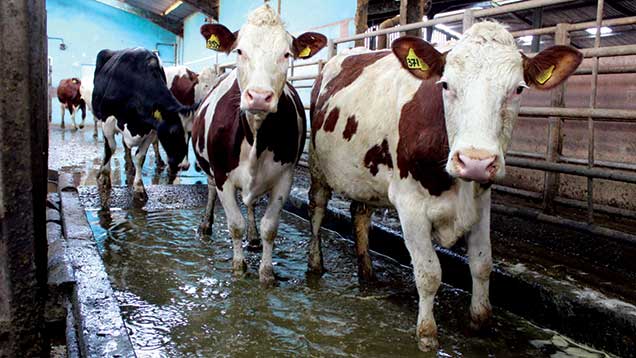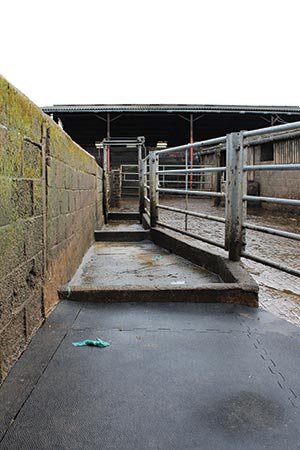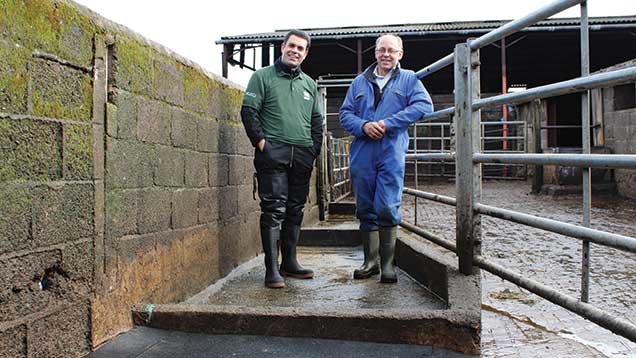Foot-bath advice to reduce digital dermatitis in cows

Dairy farmers who want to control digital dermatitis (DD) will only truly get on top of the problem by ensuring cow foot-baths are long enough to ensure hind feet are submerged in solution three times.
Lameness data collected by XL Vets practice Shepton Vets from 25 dairy units over four years shows those farms that improved foot-bath length to meet this rule saw two to two-and-a-half times the reduction in total lameness compared with those that didn’t (see table).
See also: Foot-trimming link to digital dermatitis
Foot-bath considerations for effective prevention of digital dermatitis
- Foot-bath length The most important factor. Aim for 3.5m to achieve three steps in the solution or six seconds’ contact time, whichever is longest
- Amount of water Target a minimum of 1 litre a cow
- Concentration of disinfectant Mix disinfectant correctly to meet target concentration
- Foot-bath width Aim for a minimum of 0.5m to encourage cow flow
- High sides High sides on the foot-bath will remove distractions, encourage cow flow, reduce stress and dunging and foot-bath contamination
- 10cm minimum depth The disinfectant should submerge the foot up to the coronary band
- Flat surface Avoid bumps in the base of the foot-bath to promote cow flow
- Cleanliness Cows’ feet should be as clean as possible before bathing. Cows should enter a clean, dry area after foot-bathing and baths should be cleaned regularly to ensure efficacy of disinfectant
The farms involved ranged in size from 80 to more than 800 cows and were predominantly housed systems, milked twice a day.
The farms had a range of foot-bath routines and mostly used copper sulphate or formalin disinfectant. As is typical across all UK dairy farms, up to 50% of lameness problems were caused by DD.
DD is a highly contagious, erosive infection usually affecting the skin on the bulbs of the heel. Estimates put the cost at £120 a cow.
Foot-bathing has a key role to play in preventing the spread of DD, making the foot tissue more resistant to pathogens and reducing bacteria challenge.
See also: New hoof gel to help tackle digital dermatitis
Vet Sotirios Karvountzis from Shepton Vets says the farm data clearly shows foot-bath length is the number one parameter to consider when thinking about DD.
“Farmers in the group that didn’t address foot-bath length may have improved other areas, such as scraper frequency or lying times, and as a result did see a reduction in lameness.
“However, the data shows they could have achieved more than twice the reduction in lameness if they had modified foot-bath length,” he explains.
Foot-bath length
Mr Karvountzis says all dairy farms should aim for a minimum foot-bath length of 3.5m to achieve three “dunks” of each foot in solution or six seconds contact time per foot, whichever is longest.
This follows on from similar findings from research carried out by the University of Wisconsin. The three-and-a-half minutes applies to the disinfectant bath and should not include any additional “wash” baths.
“If you change your footbath to meet these requirements – as well as bathing cows frequently, you must keep baths clean and use the right concentration of disinfectant – you will see a quick improvement in the efficacy of the foot-bath disinfectant on DD,” he says.
See also: Genetic link found to digital dermatitis in cows
“Stand back and watch cows go through the foot-bath. Focus on the back feet and count how many times they ‘plonk’ in the bath. They should be submerged three times. If they’ aren’t, think about how to make the bath longer.”
If farmers fail to address foot-bath length, it could lead to more chronic DD cases, which act as a source of infection to other animals.
Chronic cases will also be harder to treat and will inevitably require an antibiotics foot-bath treatment. Inadequate contact time will then mean antibiotics will have to be used for longer.
At about £600 for an antibiotics bath (national average), this will add considerable cost and potentially lead to antibiotics resistance.
At the same time, close attention should be paid to other contributory factors to DD. This includes keeping feet clean and dry through careful slurry management, and good cubicle comfort.
Mr Karvountzis explains how adhering to the correct bath length could also enable farmers to reduce disinfectant concentration.
“The reason disinfectant concentration recommendations are high is to overcome the length of the foot-bath,” he says. “If you get the length right you may be able to reduce copper sulphate concentration, for example, from 7.5% to 5% or formalin concentration from 5% to 2.5%.”
The total amount used won’t vary due to increased bath length, however the disinfectant will be used more effectively. There is also the potential to reduce copper sulphate concentrations further to 2.5% and reduce costs by adding acidifiers to the foot-bath.
“Using acidifiers can reduce footbath concentration, but improve the release of copper sulphate. However, their use requires safety precautions and regular monitoring of foot-bath pH to ensure it is at pH 3-3.5. Ask your vet for more details,” says Mr Karvountzis.
Effect of foot-bath length modification on total lameness |
|||
|
Lameness incidence before |
Lameness incidence afterwards |
Reduction in lameness |
|
|
Group A (Improved foot-bath length to ensure hind feet are submerged in bath three times) |
27% |
12-15% |
12-15% |
|
Group B (Addressed other factors influencing lameness, but didn’t improve foot-bath length) |
28% |
22% |
6% |
|
25 herds. Lame cows defined as mobility score 2 or 3. Up to 50% of total lameness was caused by digital dermatitis |
|||
Case study: Nigel Doman, Manor Farm, Ston Easton, Somerset
Correct foot-bath length is one of a number of factors that has almost completely eradicated digital dermatitis from the herd of 140 autumn-calving Holstein Friesians at Manor Farm.
Foot-bathing has formed a key part of DD prevention at Nigel Doman’s unit for more than 10 years. Cows are run through two adjacent concrete foot-baths three times a week with the aim of preventing DD.
Features of the footbath at Manor Farm that promote effective DD control:
- Total length of bath is more than the 3.5m minimum and disinfectant is put in both compartments (see picture below) to ensure three steps in the solution
- Foot-bath floor is the same level as the surrounding concrete, promoting cow confidence and flow
- Bath width meets 0.5m minimum
- Rubber matting on parlour exit ensures good flow and reduces pressure on feet

Having initially filled the first bath with water and used it as a wash bath, both baths are now filled with a 5% formalin solution.
“It makes sense to have disinfectant in both and have the feet in contact with it for longer,” comments Mr Doman.
This means cows are run through a total length of 4.5m, which ensures feet are submerged in the solution three times.
Mr Doman explains that prior to putting disinfectant in both baths, the farm would commonly see a flare-up in DD at the end of winter housing.
As a result they would often have to use an antibiotics foot-bath. However, since getting rid of the wash bath, antibiotics use has reduced.
“The frequency of bathing stayed the same, but the disinfectant contact time changed.
“We also made some big changes to the cow buildings and took out the kennels and replaced with sand cubicles, but even before the cubicles were changed we noticed DD was reduced,” says Mr Doman.
Automatic scrapers have also been introduced and passageways widened, which reduces the amount of slurry cows stand in.
The better cubicles also mean lying times have improved and feet are drier thanks to the sand.
However, Mr Doman believes the bath length has a significant role to play in controlling DD and has noted differences between Manor Farm and his other 185-cow dairy unit, Paradise Farm.
“Relatively speaking we have more DD at Paradise Farm and that is possibly due to less disinfectant contact time due to the shorter foot-bath,” he says.
At Paradise Farm cows are run through a standard, movable 200-litre black plastic bath, commonly used on farms.
However, this type of bath only achieve 2 to 2.3 cow steps, rather than the required three.
Mr Doman also explains that stocking rates are higher at Paradise Farm and copper sulphate is used in the foot-bath. He plans to reassess foot-bath set-up to improve contact time.
Mr Doman is so convinced of the merits of foot-bathing for preventing DD that he also foot-baths dry cows, youngstock and beef animals.
Youngstock move from Manor Farm to Paradise Farm at bulling age and are run through the mobile foot-bath on arrival and then a few times through the winter.
Dry cows are also foot-bathed with formalin weekly, and beef from the dairy herd bathed through the winter.
“It is important to make sure feet are OK before cows calve and keep DD down, otherwise there could be a flare-up – you need to constantly keep on top of it,” says Mr Doman.

